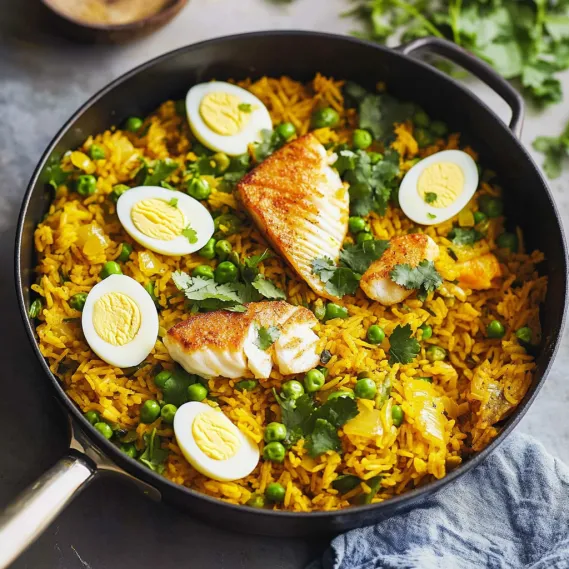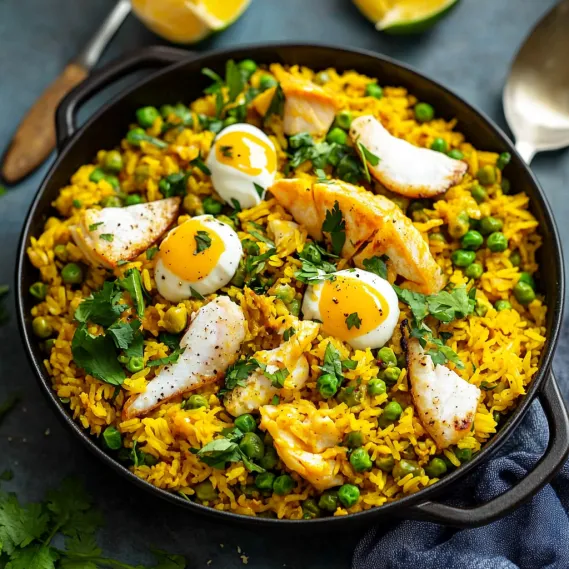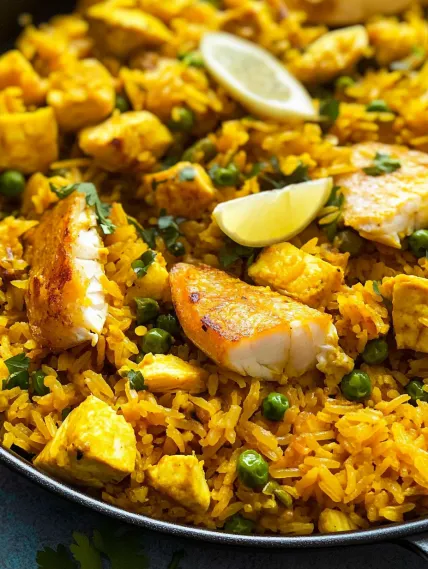 Pin it
Pin it
This hearty kedgeree has become my weekend brunch signature, combining the comfort of rice with delicate smoked fish and warming spices. The British-Indian fusion dish delivers both familiar and exotic flavors in one satisfying bowl.
I first discovered kedgeree at a small English breakfast spot while traveling through London. The combination of buttery rice, tender fish, and those perfectly jammy eggs captivated me. Back home, I spent months perfecting this version until my children began requesting it weekly.
Ingredients
- Smoked haddock or cod: Forms the backbone of authentic kedgeree with its delicate texture and subtle smokiness
- Chicken stock: Infuses the rice with savory depth while gently poaching the fish
- Long grain rice: Creates the perfect fluffy texture rather than becoming sticky or mushy
- Butter: Provides richness that carries the spice flavors throughout the dish
- Curry leaves: Add authentic aroma that transforms ordinary rice into something special
- Cardamom pods: Release their unique sweet yet spicy notes when lightly crushed
- Brown onion: Creates the aromatic foundation when slowly sautéed in butter
- Curry powder: Offers complex spice without overwhelming heat, look for a quality blend with warm notes
- Turmeric: Adds that signature golden color and subtle earthy flavor
- Frozen peas: Bring freshness and bright color contrast to the golden rice
- Hard boiled eggs: Create that classic kedgeree presentation and add creamy richness
- Fresh coriander: Brightens everything with its distinctive finish
How To Make Kedgeree
- Poach The Fish:
- Place the smoked fish in simmering chicken stock until just cooked through about 8 minutes. The gentle heat ensures the fish remains moist and tender while infusing the stock with smoky flavor. This poaching liquid becomes a valuable ingredient for the rest of the dish.
- Prepare The Fish:
- Once the fish is cool enough to handle carefully remove the skin and flake the flesh into substantial pieces. Aim for chunks large enough to provide texture in each bite rather than shredding too finely. Check thoroughly for any small bones that might remain.
- Cook The Rice:
- Use the same flavorful poaching liquid to cook your rice creating layers of flavor. The covered 13minute simmer followed by a 10minute rest without peeking is crucial for perfectly fluffy grains. The fish stock infuses every grain with delicate seafood essence.
- Create The Spiced Butter Base:
- While the rice rests melt butter in a large skillet and toast the cardamom pods and curry leaves until fragrant. This aromatic foundation transforms the dish from ordinary to extraordinary. When the onions reach golden brown edges they release their natural sweetness.
- Build The Flavor Layers:
- The magic happens when you combine the curry powder and turmeric with the buttery aromatics creating a richly spiced base. When tossed with the cooked rice each grain becomes coated in golden spiced butter. Adding back some reserved poaching liquid keeps everything moist.
- Incorporate The Final Elements:
- Gently fold in the peas coriander and flaked fish with a light hand to maintain the integrity of the fish pieces. This careful final assembly ensures perfect distribution of ingredients without breaking down the delicate fish.
- Serve With Flair:
- Top with halved eggs and a sprinkle of fresh herbs for a presentation that balances rustic comfort with elegant appeal. The contrast of golden rice white fish and vibrant herbs creates an impressive visual.
 Pin it
Pin it
The cardamom pods are my secret weapon in this recipe. While many modern versions omit them I find they add that indefinable aromatic quality that elevates the entire dish. My grandmother who lived in colonial India always insisted that proper kedgeree needed their floral complexity, and after trying it both ways, I completely agree.
Storage Solutions
Kedgeree keeps beautifully in the refrigerator for up to three days, with many claiming it tastes even better on day two as the flavors meld. Store in an airtight container and reheat gently with a splash of water to revive the moisture. I recommend removing the egg portions before storing and adding fresh ones when reheating for the best texture experience.
Ingredient Adaptations
While traditional kedgeree features smoked haddock, any smoked fish works wonderfully. Smoked trout or salmon make excellent alternatives with their rich flavor profiles. For a nontraditional but delicious version, try using hot smoked mackerel or even leftover roasted chicken. Vegetarians can substitute smoked tofu and vegetable stock for a plantbased variation that maintains the distinctive kedgeree character.
 Pin it
Pin it
Historical Context
Kedgeree represents the perfect example of culinary fusion born from British colonial influence in India. The dish evolved from khichdi, a simple Indian rice and lentil comfort food. British colonials fell in love with the spiced rice dish and brought it back to England, adding smoked fish and eggs to create what became a Victorian breakfast staple. Today it remains popular throughout the UK, especially in Scotland where abundant local fish supplies make it particularly delicious.
Serving Suggestions
Kedgeree shines as a standalone dish but pairs wonderfully with accompaniments. Serve with mango chutney and cooling cucumber raita for an expanded flavor experience. A simple green salad dressed with lemon vinaigrette provides fresh contrast to the rich, spiced rice. For an elegant brunch presentation, offer warm naan bread and a selection of pickles alongside your kedgeree.
Frequently Asked Questions
- → What type of fish can I use for kedgeree?
Traditionally, smoked haddock is used, but you can substitute with other smoked fish like cod or even trout.
- → Can I make kedgeree ahead of time?
Kedgeree can be made ahead, but it's best served fresh. Reheat gently to maintain its texture and flavor.
- → Are curry leaves necessary in this recipe?
Curry leaves add a subtle depth of flavor but can be omitted if unavailable. You could substitute with a bit of extra cilantro.
- → What rice works best for kedgeree?
Long grain rice is ideal for kedgeree as it yields fluffy, separate grains perfect for this dish.
- → How spicy is kedgeree?
Kedgeree is mildly spiced, depending on the curry powder used. You can adjust the heat level to suit your taste.
- → What can I serve with kedgeree?
Kedgeree is a complete meal on its own but pairs well with a fresh green salad or a dollop of yogurt for balance.
